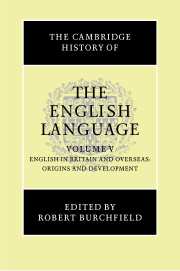Book contents
- Frontmatter
- 1 Introduction
- PART I Regional varieties of English in Great Britain and Ireland
- 2 ENGLISH IN SCOTLAND
- 3 ENGLISH IN WALES
- 4 ENGLISH IN IRELAND
- 5 THE DIALECTS OF ENGLAND SINCE 1776
- PART II English overseas
- Glossary of linguistic terms
- Bibliography
- Index
- THE CAMBRIDGE HISTORY OF THE ENGLISH LANGUAGE
- Map 7.1 Movements of English/Creole speakers in the seventeenth century
- Map 7.2 Movements of English/Creole speakers after 1700
- References
4 - ENGLISH IN IRELAND
from PART I - Regional varieties of English in Great Britain and Ireland
Published online by Cambridge University Press: 28 March 2008
- Frontmatter
- 1 Introduction
- PART I Regional varieties of English in Great Britain and Ireland
- 2 ENGLISH IN SCOTLAND
- 3 ENGLISH IN WALES
- 4 ENGLISH IN IRELAND
- 5 THE DIALECTS OF ENGLAND SINCE 1776
- PART II English overseas
- Glossary of linguistic terms
- Bibliography
- Index
- THE CAMBRIDGE HISTORY OF THE ENGLISH LANGUAGE
- Map 7.1 Movements of English/Creole speakers in the seventeenth century
- Map 7.2 Movements of English/Creole speakers after 1700
- References
Summary
Introduction
A complex series of population movements and language contacts lies at the heart of the history of Irish English. Included in this history are the establishment of Viking shipping and trading towns in the ninth century, the first arrival of English-speakers in 1169, and the subsequent English and Scottish plantations of the seventeenth century which culminated in an overall shift during the nineteenth century from Irish to English as the most common vernacular language. The effects of this population movement and linguistic contact on both the internal linguistic structure of Irish English and on the development of sociolinguistic attitudes provide a background against which most analyses of Irish English take place. The development of English in Ireland, then, is seen in this chapter from two points of view: the external history of the diffusion of English is discussed in section 4.2, while internal linguistic developments are examined in section 4.3. Further topics arising from this discussion are treated in section 4.4.
The term Irish English is used here simply to denote the English language as spoken in Ireland. Henry (1958, 1977, 1986) suggests a division between Anglo-Irish as the term for English spoken in areas which have only recently become predominantly English-speaking and Hiberno-English as a term denoting urban varieties with a longer history. Todd (1989a) uses these two terms with virtually the opposite signification. ‘Anglo-Irish’ also commonly refers to the variety of English spoken in Ireland in the Middle Ages (see Irwin 1935; Mcintosh & Samuels 1968), while ‘Hiberno-English’ often denotes both the English language in Ireland generally and the field of research into this variety (see Barry 1981b; Harris 1985a; Filppula 1986).
Keywords
- Type
- Chapter
- Information
- The Cambridge History of the English Language , pp. 148 - 196Publisher: Cambridge University PressPrint publication year: 1994
References
- 10
- Cited by



